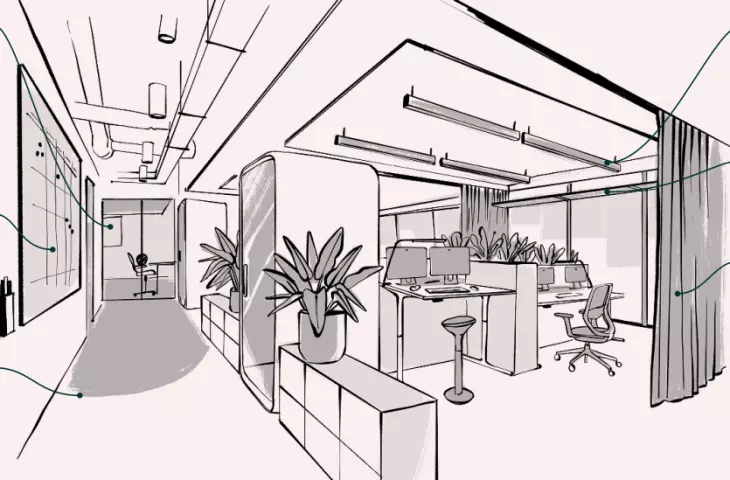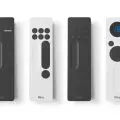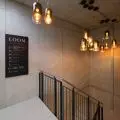A good work space is one where everyone can feel comfortable. A place without barriers. There is still a lot of work to be done in this field, as can be seen by how few people know what the term "neurodiversity" means.
"Neurodiversityin the office" is the title of a report that Workplace studio has compiled. Dominika Zielińska, Natalia Olszewska, Aleksandra Piotrkowicz and Barbara Majerska tried to point out the direction in which architecture and interior design should go when designing for neurodiverse people - so as to take into account the needs of excluded people.
scale of neuroatypical people
© Workplace
We talk to Natalia Olszewska, Aleksandra Piotrkowicz and Dominika Zielinska about where the term came from and why it's important to consider the needs of neuroatypical people
Wiktor Bochenek: Let's start at the beginning. You are blazing a trail when it comes to designing for neurodiverse people. Why is this process important and what is most difficult about it?
Dominika Zielińska: In blazing the trail, it is important to build awareness that this topic exists at all. It's worth starting with a definition of what neurodiversity is and understanding that it accommodates the entire spectrum of human minds - from the typical to the atypical. A history of definitions also appears in the report to point out that this is a topic whose understanding is evolving and will continue to change in the future.
Natalia Olszewska: In order to actually design offices consciously, taking into account the needs of neuroatypical people, we need to draw on knowledge from the field of neuroscience, which explains to us how the brains of different space users, both neuroatypical and neurotypical, work. Collaboration of an interdisciplinary nature was necessary to develop the report; at the same time, such collaboration is often a challenge, if only because specialists within interdisciplinary teams often speak a different language. This is à propos challenges.
It is interesting to know under what circumstances the term "neurodiversity" was coined. The term " neurodiversity," in English neurodiversity, was introduced in 1997 by Judy Singer, an Australian sociologist. It's a neologism that Singer created by combining two words: neuroscience and diversity. "Neuro-" was a reference to the dynamic development of neuroscience, while "diversity" was a political term and derived from the civil rights movement for African-Americans. Singer was aware that the word "neurodiversity" applied to all of humanity because our brains are diverse, but the movement for neurodiversity was and is essentially a political movement for people who demand their rights.
It wasn't until 2013 that the American magazine Wired published a special issue devoted to the most influential ideas of the past two decades and published a text by Steve Silberman titled "Neurodiversity Rewires Conventional Thinking About Brains," in which Silberman paid tribute to Judy Singer. This was a watershed moment for the neurodiversity movement.
the elements that make up neuroinclusive design
© Workplace
Wiktor: And what is this awareness of diversity? What does it look like from your perspective? I remember one of the surveys shown in the report that asked 16 questions. It was quite interesting, because people who thought they knew a lot about neurodiversity had similar results to those who said they knew nothing. What is that level of knowledge today?
Dominica: The term exists in awareness, but the level of knowledge varies. It was a big challenge to find a balance between very scientific, difficult language, which is natural for scientists, and conveying knowledge in a way that can be understood by people who might download the report because the term is becoming fashionable. There is no denying that this fashion is taking off, and the prefix "neuro," like the prefix "eco" before it, is increasingly being added to various initiatives. This is a dangerous phenomenon that can be called "neuro-washing."
We tried to create a starting point for a conversation. On the one hand, understandable to people who are not experts - maybe they design spaces, or maybe they work with neuroatypical people, and on the other hand, we tried to avoid oversimplifications, which are often harmful. We were helped by Agnieszka Starzynska from Saints, who took great care to make the language of the report accessible, readable and inclusive, and the girls from Tinge Studio, who took care of the inclusive graphic design. Our partners Skanska and Business Link also had a big role, of course - the idea for the report came from the bottom up, from their employee network.
We conducted the survey you mentioned earlier specifically for this report, using our own and our partners' database of business contacts. It showed very clearly that it is easy to be fooled by the illusion of one 's own knowledge. There was a question about assessing one's own level of knowledge on an issue, followed by a quiz. Interestingly, regardless of the declarations about one's own knowledge, the level of awareness was very similar: 9-10 correct answers out of 16.
Aleksandra Piotrkowicz: I would add that these 9-10 correct answers are about 56-60%, it seems to me that the perception of the result is different in this way. It is also important that 55% of respondents in general correctly indicated the basic definition of what neurodiversity is. Whether this is a lot or a little - you have to answer for yourself.
survey, conducted as part of the creation of the report
© Workplace
Wiktor: Previously, no one has raised this topic in public specifically, because, as you yourself mentioned, this is an issue that many people will need to be convinced of, as not everyone sees value in designing for neuroatypical people. What would you say to such skeptics - people who don't quite see the point in neurodiverse design? Is it even worth talking to them?
Dominica: As with any innovation topic, no one has ever come and asked for it. Our role as architects is to constantly acquire up-to-date knowledge and then share it and educate investors. We show what is possible today in the world and in Poland, what solutions we already have, and encourage them already at the bidding stage.
Natalia: In essence, it's not so much about neuroatypicality issues, but about inclusion and support of different groups of space users by taking into account their characteristics and needs.
From my point of view, there are two arguments that can be used to talk to skeptics. The first is this - neuroscience research shows that space affects our biology, including our brain. That is, our brains can perform better or worse, depending on where they are.
In the report, we use the term "neuroinclusion" to emphasize the fact that the report is about user support at the neurobiological level. I'd also add that public awareness and efforts to address barriers for people with physical disabilities are somewhat more advanced.
example of a board with solutions for office spaces
© Workplace
For neuroatypical people, it's about removing sensory and cognitive barriers in space. The consequences of failing to address the environmental needs of this group can be serious, as people who do not feel "included" in a group or space can be subjected to chronic stress due to the fact that their need for a sense of belonging, a very important need for every human being, is not being met. This phenomenon has potentially negative consequences for both mental and physical health. This is the second argument.
Alexandra: I would also add that designing for extremes improves conditions for everyone. Even for a hardened skeptic, that's the argument - that by taking care of minorities, most people also get better working conditions.
Wiktor: You have explained why it is very important to create the right working conditions for neuroatypical people. And what is most important in the design process?
Dominica: I think each of us will first say research. One size does not fit all - even if we have created some base of solutions, the possibilities do not end here. This is the aforementioned tip of the iceberg.
We, as a research and design company, have been very nurturing on the topic of research for 10 years. We make sure that we don't rely only on the investor's feelings or intuition, but also verify the needs of later users. In creating the report, we realized that we had certainly talked to atypical people over the years in in-depth interviews, even if they were not aware of it. Without calling it neuro-inclusivity, we responded to atypical needs in projects, created solutions by co-creating with users, verifying prototypes and then conducting post-implementation evaluations. As designers, we are ready for feedback, because it allows us to grow. That's why in the report you can find photos of our realizations, in which we responded, at least in part, to the challenges of atypical people.
Thearchitectural profession is a profession of public trust - that's why we want to share knowledge that can help everyone design better.
Natalia: In my experience of working with architects, it is important in the design process to have both an empathetic dialogue with the people for whom the spaces are being designed, and additionally to gather an adequate pool of research that allows a deeper understanding of the needs of the users of the designed space. As a neuroscientist, I believe that users are not always aware of their needs, and declarative data does not always reflect the actual state of affairs.
Impronta would like to contribute to this type of research. We are planning to do an experimental study on how appropriately designed natural light and artificial light can affect the attention processes of students diagnosed with ADHD, supporting their ability to concentrate.
At the moment we are at the stage of completing the research team and developing the methodology for such research. I will point out that we are looking for sponsors.
implementing good practices
© Workplace
Dominica: As designers and architects, I think we often don't realize what an incredible impact we have on people's health. I really like the statement I once heard from Natalia that neuroscience is a tool to verify the intuition of an architect or designer. I think many of them intuitively design well and healthily, and it would be good if this was knowledge, along the lines of a design manual, that can be used consciously. It's not about creating a "new Neufert," which by the way is very exclusionary, but about looking at architecture from the side of empathy.
Wiktor: Do you see a chance for these principles and recommendations presented in the report to become widespread? Do you see such a possibility that neurodiverse design will be something almost as common today as designing for people with disabilities?
Natalia: In my opinion, design based on the achievements of neuroscience and knowledge of the brain and human physiology, or newly emerging fields such as neuroaesthetics or neuroarchitecture, is the future of architectural design. In fact, it is already happening....
The future, and a very important topic, is also the marriage of architecture with public health, or preventive health. In a way, something has moved in this context in connection with the development and entry into the global market of the WELL standards. From my point of view, the universal dimension of these standards is a double-edged weapon; these guidelines can be applied all over the world, but they remain at a high level of generality and do not take into account the specifics of the space and group we are designing for. Nevertheless, the global success of these standards is a major advance in efforts and actions to design spaces that support health and well-being.
What could help us a great deal in implementing on a larger scale design solutions that support neuroinclusion, or human health and well-being in general, are changes to the provisions of building laws.
The English are one step further when it comes to building law. They have established a new design standard called "Design for the Mind," which prompts space designers to take into account "neurodiversity."
Building office space with neuro-inclusive design methods in mind
© Workplace
Wiktor: Is there a chance to introduce such regulations in Poland?
Dominika: I think there is. You can already see what is happening in terms of sustainable design, after the European Union tightened the law. The ESG reporting obligation has made implementations appear. As long as the law doesn't require something, both the developer and the architect opt out of certain elements, usually because of cost.
Natalia: Design paradigms are also changing, and we are seeing a steady increase in knowledge. However, I would like to return to the "neuro-washing" that one of you mentioned. It is known that a certain group is trying to keep up with certain trends at all costs, while keeping up appearances.
Nevertheless, the fact that the prefix "neuro" is so successful also reflects advances in neuroscience and the widespread interest in how the human brain and mind work. It is natural and inevitable that knowledge is beginning to permeate very different disciplines. This phenomenon also applies to architecture or urban planning.
There is talk today of "neuroarchitecture." Even very serious researchers are beginning to use the term. Our knowledge of how space affects humans has deepened over the past 10-15 years. This is not a long period from the point of view of a newly emerging field, but it is knowledge that can already be used, and can be implemented to improve the quality of the experience of space users. The question - how many architects today incorporate this knowledge into design?
Dominica: Do we even see an opportunity for these implementations? It's not a question of if, but when. For us, it's obvious that we need to integrate neuroscience into design, and we are trying to do so wherever we can, to a greater or lesser extent. In the aforementioned survey conducted for the report, 95% of respondents see the possibility of making changes in their organization at selected points.
Alexandra: I would add that in the report you can find a checklist with very small interventions that are already improving the comfort of neuroatypical people. So maybe the first step would be to review it.
Victor: Thank you for the interview.
A checklist that managers can use in their workplaces
© Workplace
interviewed by Wiktor Bochenek
Dominika Zielinska - co-CEO, Futures Designer and chief architect of Workplace studio where for almost 10 years she has been responsible for developing and managing a team of architects, designers and researchers, focusing on systems thinking and the idea of life-centered design. She specializes in designing the future for business, working at the intersection of research, strategy, architecture and urban planning. In the projects he leads, he combines the needs of clients and users with values that are important to people, communities and the environment.
Natalia Olszewska - Co-founder and Research Lead at Impronta, an Italian-Polish design consultancy for health and well-being, specializing in translational research from neuroscience and behavioral sciences into architectural language. She is a lecturer at the NAAD (Neuroscience Applied to Architectural Design) course organized by Iuav University in Venice. Her experience in neuroscience-informed design included working with Studio Hume, an avant-garde architecture and urbanism studio founded by Itai Palti. She has consulted on projects for both individual clients and large companies: Landsec, HKS Architects, EDGE, Association of Children "s Museums & Center on the Developing Child of Harvard University, Google. She also has more than 10 years of medical practice. She has a degree in medicine, neuroscience and applied neuroscience in architectural design.
Aleksandra Piotrkowicz - architect and researcher at Workplace. Abslowentee of Interior Design at the Academy of Fine Arts and Service Design at SWPS. Designer with a wide range of competencies. On the one hand, she specializes in research and participatory processes and designing close to the user and his needs both functionally and aesthetically. On the other hand, she deals with strategic projects combining research and environmental competencies with business strategy at the scale of architecture and urbanism.
Barbara Majerska - architect and researcher at Workplace. She is a PhD student at the Warsaw University of Technology. Barbara specializes in human-centered, biophilic and highly functional design. Working in both academic and business environments, she is able to combine best practices from both areas. She focuses on a holistic approach to design, combining architectural and urban design with social, behavioral and health aspects. She is interested in the topic of human well-being in architecture and the built environment. She is able to systematize and simplify the most complex process.
















































